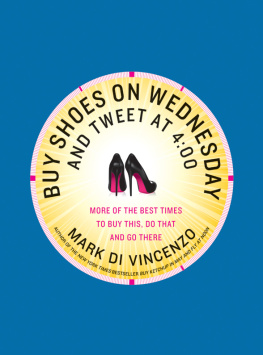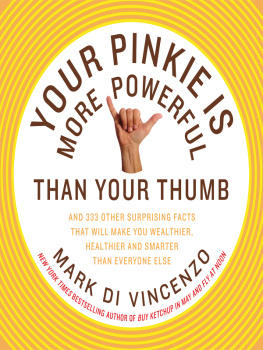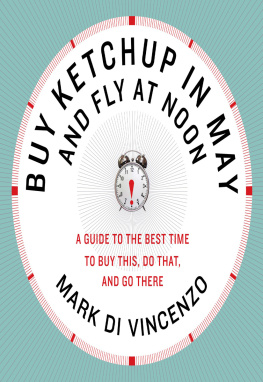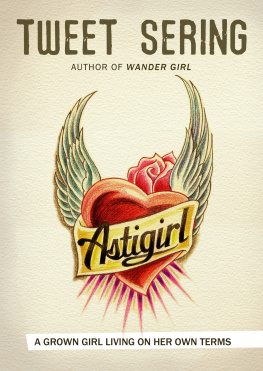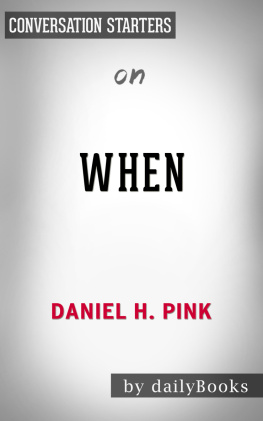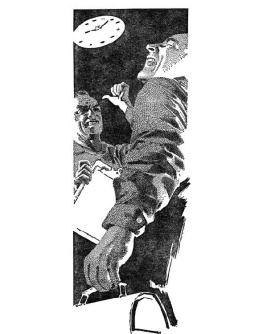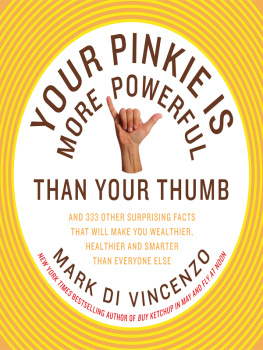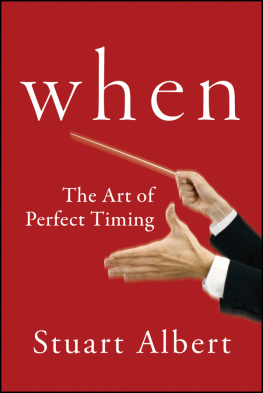FOR FRED AND TONI DI VINCENZO
CONTENTS


T his book is crammed with tips and advice from dozens of experts, and Id like to thank them here collectively for all of the great information they provided.
I also owe a debt to Kate Nintzel, my editor, for all the big and little things she did to make this book interesting and useful, and to Michelle Wolfson, my agent, for her encouragement, her business smarts and her tweets.
As always, thanks to Jayne, my incredible wife, for her patience, wisdom and love.

L et me get this confession out of the way in the first sentence: I didnt think I could write this book.
After Buy Ketchup in May and Fly at Noon: A Guide to the Best Time to Buy This, Do That and Go There was released, readers asked me if I planned to write a follow-up. I said no, forget about it, its not going to happen. Then, a few months later, they went from asking me to do it to urging me to do it. I didnt want to even consider it, but I knew why they became so insistent. Buy Ketchup, which I initially thought might not even attract an agent let alone a publisher, became very popular very quickly. Readers devoured the books best-time tips, and soon after the release date in the fall of 2009, I promoted it on Rachael Ray, All Things Considered and other national TV and radio shows. Entertainment Weekly placed the book on its coveted back-cover Bullseye feature, and Buy Ketchup landed on the New York Times best-seller list for several weeks toward the end of 2009. Glossy magazines and large and small newspapers from coast to coast reviewed it or reprinted information from it. Interview requests from as far away as Australia poured in well into 2010 and continued into 2011, and during those years, the book was also published in Russian, Italian, Turkish and Japanese.
So why not write a second edition and try to hit it big again?
Buy Ketchup ended up being about 175 pages long, but it could have been at least 500. I edited a ton of information down to a relatively slim book because I wanted everything in itand I mean everythingto be of interest to the masses. If I removed a tip from the book during the editing process, I did it because I didnt think the housewife in Des Moines or the lawyer in Atlanta would find it relevant or interesting. Buy Ketchups success made me think I made the right choices to keep what I kept and omit what I omitted. In my mind, all the best and most relevant timing tips were in Buy Ketchup, so a second edition couldnt possibly offer readers enough of what they loved about the first book.
I was wrong. Very wrong.
After brainstorming with some smart people who saw great potential in a second edition, I went to work and discovered that there was much more material with widespread appeal and that this book could give readers hundreds more great tips about the best time to buy and do things and go places. I want you to know that this book contains none of the information that I deemed unworthy to be in Buy Ketchup.
This book and Buy Ketchup do have at least two very important things in common. First, the information in both books comes from experts, whether theyre doctors and lawyers or mechanics and plumbers. Second, both books cover topics that the vast majority of us care a lot abouteverything from money and health to travel and food. Of course, both books also include lots of tips on the best time to buy and do a wide range of things that will help you save more money, make more money and make better use of your time.
If youre familiar with Buy Ketchup, youll notice that this book is different in some pretty obvious ways. For one thing, this book has fourteen chaptersseven more than in the first edition. Because it has twice as many chapters, it includes an even wider range of topics and subjects, such as whole sections on beauty tips, pets, cars and children as well as lots of information on the best times to get rid of things, such as perishable food, medicine and other things we may no longer want.
As I write this, I realize another difference is that this timebecause there is so much I wasnt able to cover in this bookI know there probably is a third and maybe even a fourth edition to write. So stay tuned.

A bout twenty-five years ago, I clipped a front-page graphic in USA Today about the best months of the year to buy furniture, kitchen appliances and other big-ticket items. I stuck it under a refrigerator magnet, referring to it, oh, about fifty times a year until it turned too yellow and faded for me to decipher anything from it. Knowing when to buy things has always been an interest of mine. If you can save a few bucksor a few hundred bucksby knowing when to make a purchase, why wouldnt you do it? The buying chapter in Buy Ketchup in May and Fly at Noon is arguably that books most popular chapter, so it only makes sense to lead off this book with a chapter devoted to tips on the best time to buy things. In the following pages, youll learn the best time to buy everything from TVs, textbooks and timesharesdont do it!to the best time to upgrade your computer.
WHICH IS THE BEST MONTH TO BUY A HIGH-DEFINITION TV? December is a great month to buy a lot of things, TVs included. But during years when TVs dont sell well in December, look for excellent postholiday sales, which stretch into the first half of January. Sales leading up to the Super Bowl in early February are very rarely super, despite common assumptions. Think about it: Why would retailers offer great deals when the demand is high? Do you see great prices on jewelry right before Valentines Day? Any Super Bowl TV Sales you see in late January and early February typically come after retailers jack up the regular prices. Second opinion: Sales for older-model HDTVs can be very good in March and April. Electronics, including TVs, often go on sale then, when Japanese manufacturers release new models and retailers cut prices on older models.
WHICH IS THE BEST DAY OF THE WEEK TO BUY THINGS ONLINE? ShopItToMe.com, which tracks online sales from more than a hundred retailers, came up with this list:
MONDAYS: Mens and womens dress pants, on which shoppers can save nearly 50 percent. They can save more than thatabout 55 percentbuying sunglasses.
TUESDAYS: Mens apparel. Expect to save more than 40 percent.
WEDNESDAYS: Shoes and childrens clothes. Shoppers save about 40 percent on both.
THURSDAYS: Womens handbags. The average discount is 36 percent.
FRIDAYS: Jewelry, belts and scarves. The average discount is 42 percent.
SATURDAYS: Lingerie (37 percent off) and jackets/outerwear (51 percent off).
SUNDAYS: Swimsuits (52 percent off).

